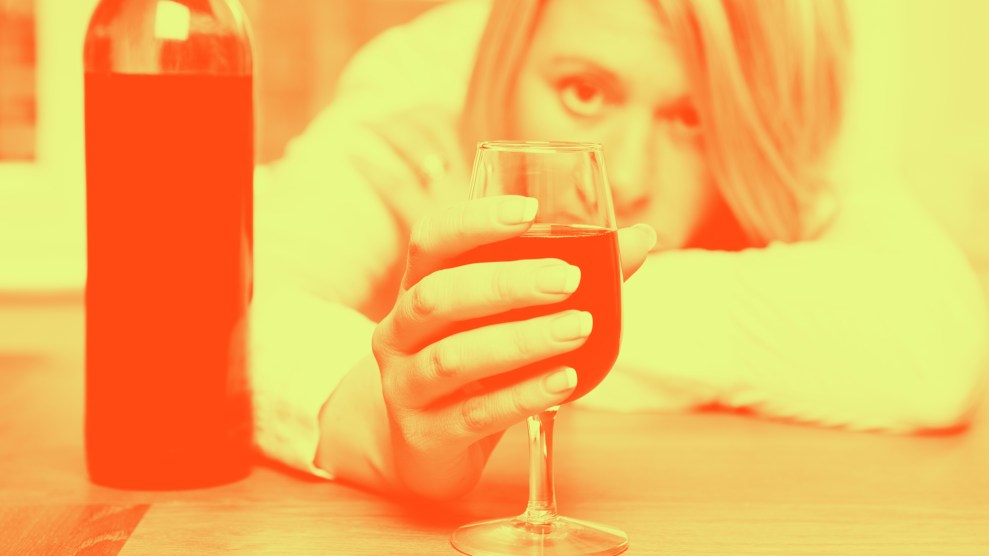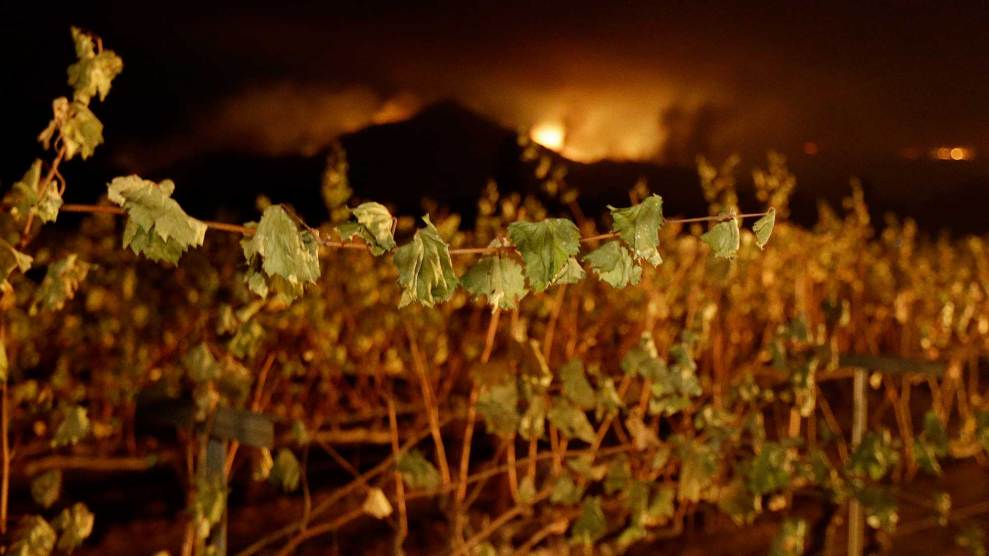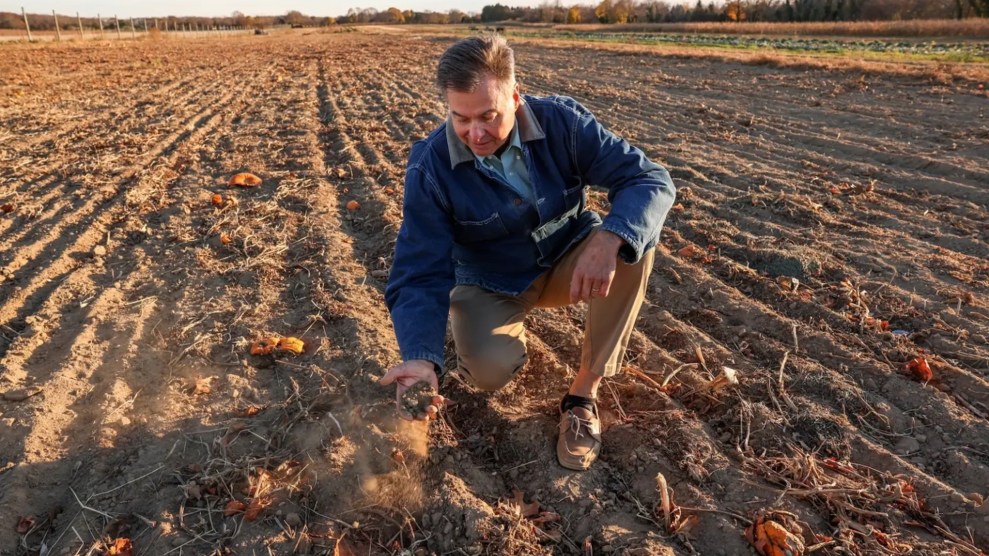
Mother Jones; Getty
Larkmead Vineyards in Calistoga, California, embodies the Napa Valley of popular imagination. At the beginning of harvest, vines heavy with inky clumps of grapes stretch out in perfect rows, their leaves showing the faintest yellow tinge of autumn’s impending turn. The grapevines run for 110 acres to the base of the Mayacamas and Vaca Mountains, interrupted only by the occasional service road and a quaint white farmhouse.
But picturesque landscapes are not what Dan Petroski, Larkmead’s winemaker, wants to show me when I arrive at the 124-year-old vineyard at the end of August. Instead, he trots me over to an empty field. “This is our future,” Petroski declares, spreading his arms proudly in the direction of the ruddy expanse of gravely, clay-based soil. “This is three acres we are committing to the next 21 years to figure out what’s going to be the next great wine grape of Larkmead—and hopefully of Napa Valley.”
Follow Kara to Napa and hear more about why wine matters in the conversation about climate change on our latest episode of Eating in Climate Chaos, from Bite podcast:
Right now, the distinction belongs to the cabernet sauvignon grape, which accounts for more than 80 percent of Larkmead’s annual harvest and produces the type of cabernet wines that have defined Napa for decades. A wine made with Napa cabernet sauvignon grapes, picked at the height of ripeness, will be intensely flavored with ripe plum, black currant, and floral notes. But as the valley sees warmer nights, less fog, and more days that surpass 100 degrees, Petroski and his fellow Cabernet producers are struggling to ripen their grapes as they lose the conditions that once gave their wines a flavorful edge. As the planet trends warmer, a number of researchers predict that, at some point in the next two to three decades, cabernet will stop thriving in Napa.
Wine grapes grow only under very specific conditions: the narrow bands of 30 to 50 degrees of latitude in each hemisphere, where the average temperature during the hottest months hovers in the mid-60s and just south of freezing during the coldest. Their sensitivity makes them a bellwether for climactic shifts, sounding the alarm for agricultural production more broadly.
Mother Jones first wrote about the wine industry’s fate at the hands of climate change in 2010, back when grape growers were merely speculating what a warming planet might do to their fragile product. “We have no idea what effects global warming will have on the conditions that affect Napa Valley wines, so to prepare for those changes seems to me to be whistling past the cemetery,” John Williams, co-founder of Napa’s Frog’s Leap Winery, said at the time.
Now, Petroski and his fellow winemakers do have an idea of what those effects will be, and he and others are pouring tens of thousands of dollars in experiments that may help them adapt. They believe that Napa, with the success and wealth of its wine businesses, may be in the best position to develop the creative solutions that help farmers prosper in the new normal. Starting next year, Petroski will embark on a 21-year experiment to determine which grape varieties might thrive in Napa’s warming climate. “With this climate—which has been a utopia for growing great wine grapes for the last 50 years—will it be the same grapes we’ve had success with in the last 50 years?” Petroski wonders. “Or is there going to be a whole new set of grapes that we have to evolve to?”
Napa Valley’s metamorphosis from hinterland to a dominion of fine wines is a thing of legend. In 1966, Robert Mondavi opened the first major post-Prohibition winery in Napa with a grand ambition: To turn a region known primarily for its low-quality bulk and sacramental wines into a mecca for the most highly sought vintages in the world. The region’s hot days, cool nights, and low rainfall bore uncanny similarities to the dry Mediterranean climate of Bordeaux, France, which had for centuries produced the world’s most celebrated wines. A flock of like-minded disciples followed Mondavi’s lead, planting grapes that defined Bordeaux’s blends—most significantly, cabernet sauvignon. By the mid-1970s, Mondavi and his allies had succeeded: A blind tasting held in Paris in 1976 declared Napa’s Bordeaux-style wines to be better than their forbearers’. Today, cabernet vines cover 51 percent of Napa’s 46,000 acres, and the 2018 crop reached $1 billion in value.
For more than half a century, vintners specializing in Cabernet have enjoyed near-perfect growing conditions in Napa. The region’s summer days begin with a layer of fog—something winemakers call “refrigerated sunshine”—that burns off by midday, providing just the right amount of heat required to develop sugars in the grapes that give wine its sweetness and alcohol. Cool nights follow with a temperature shift of nearly 50 degrees on average, which builds the fruit’s acidity, a necessary counter to the sugar. The grapes generally hang on the vine until late October, giving them enough time to develop a complex tannic structure—the compound that gives wine that drying mouthfeel red-wine drinkers have been conditioned to crave.
But not this year. Petroski and I walk over to nearby cabernet sauvignon vines and taste a couple of grapes. They’re nearly fully baked, Petroski says; he’ll pick his first red wine grapes just after Labor Day. “It’s August,” he says. “This is the right time to be picking sauvignon blanc, but red wine grapes—you wouldn’t normally expect to pick them this early.” The evenings haven’t been getting as cool as they used to, meaning there isn’t as much morning fog. On average, Petroski’s picking red wine grapes four weeks earlier than he had been when he first started making wines for Larkmead in 2006. In some years, he’s picked them at the end of August, two months earlier than their expected date of ripeness.
Early isn’t a major problem for now. Petroski cloaks 90 percent of the grapes with shade cloth to help regulate the early morning temperatures. But he’s imagining a not-so-distant future when the evenings never get cool, or the shade cloth doesn’t help. Based on current historical averages, Napa only sees two days a year with a heat index above 100 degrees. By 2050, the region can expect to see between 15 and 30 days above 100 degrees, according to a July report from the Union of Concerned Scientists. At that temperature, grapevines generally stop production: They’ll halt the process of turning sunlight into energy, stunting the growth of the plant and the fruit. If the hot temperatures sustain, vines lose their leaves.
As for the grapes? “Raisins,” Petroski says, a kind of stewy, sugary mess that more closely resembles jam than wine. If Napa’s temperatures continue to climb, he imagines cabernet will turn into an “out-of-balance, no-flavor, kind of insipid grape that looks great but tastes terrible.”
Next year, Petroski plans to test out seven grape varieties that he doesn’t currently grow on the Larkmead property. He’ll try a few grapes known to thrive in hotter Mediterranean climates, like touriga nacional, the Portuguese grape at the heart of port, and tempranillo, which is the base of Spanish Rioja. He’ll also plant some zinfandel and petite syrah, varieties that do well in California’s Central Valley, a bit south of Napa.
“What we’re hearing and what science is telling us is that the entire coast of the United States is going to shift its weather pattern by 120 miles north in 20 to 30 years,” Petroski says. “So if we have to think of what’s a hundred miles south of us and they’re growing Zinfandel and Petite Syrah and are doing well with it—that’s going to be our climate in 20 years. We need to be thinking about that here.”
Other growers in Napa have been thinking about this, too, as the San Francisco Chronicle’s Esther Mobley has reported. Spottswoode Winery, another family-owned producer five miles southeast of Larkmead, is similarly testing out other varieties. Andy Beckstoffer, one of Napa’s most renowned cabernet grape growers, is working with the University of California, Davis, to develop 100 different combinations of grape plant clones and rootstock to find one that is drought-tolerant and has a longer ripening cycle that will counteract the natural proclivities of the current plants vintners favor. There’s some urgency in figuring out which grape merits the investment: A 2011 study found that the amount of land in Northern California suitable for growing wine grapes could decrease by half by the year 2040 due to climate change; around the world, the amount of suitable land will shrink by 23 to 75 percent by 2050.
In a world in which half a billion people live in places rapidly turning to deserts, and increasing droughts, floods, and storms further threaten the 10 percent of the world’s undernourished population, caring about the future of wine may seem a bit frivolous. Watching wealthy diners waste $10,000 on a bottle of wine, in fact, is what pushed Corbin Trent, an activist who helped bring Rep. Alexandria Ocasio-Cortez into office and serves as her campaign’s communications director, to leave his job as a chef and move into politics, where he could correct the economic forces that enabled such behavior, the Intercept’s Ryan Grim detailed in his new book. Wine is but a tiny percentage of the world’s agricultural production, and Napa is but a drop in that very small bottle: Only 0.4 percent of the world’s wine comes from the valley.
Elizabeth Wolkovich, an associate professor of forest and conservation sciences at the University of British Columbia, used to have similar misgivings. “Climate change is such a major issue—we should be talking about people who experience food insecurity and the foundational issues of getting by,” she says. “And yet, people were much more interested in talking to me about what was happening to their Bordeaux.”
But over time, her thinking has changed: Now, she welcomes people drawing connections between the food they’re enjoying and changes on a grander scale. “Anything that engages people is a great way to talk about climate change,” she says. “We all have to start the conversation somewhere and wine is a great place to start.”
As for Petroski, he has started viewing the luxury product as an opportunity. His wine’s financial success has given him and his fellow vintners the ability to refine their agricultural practices—something that could, in turn, benefit agriculture as a whole as it strives to adapt to a new climate. In many respects, Petroski has inherited Mondavi’s ambition, but with a new goal in mind. “Because of the success we’ve had with our travel and our tourism and hospitality, there’s money in this valley to invest in being leaders,” Petroski says. “If we truly believe the statement that wine is made in a vineyard, then we should be the best vineyard farmers in the world.”

















